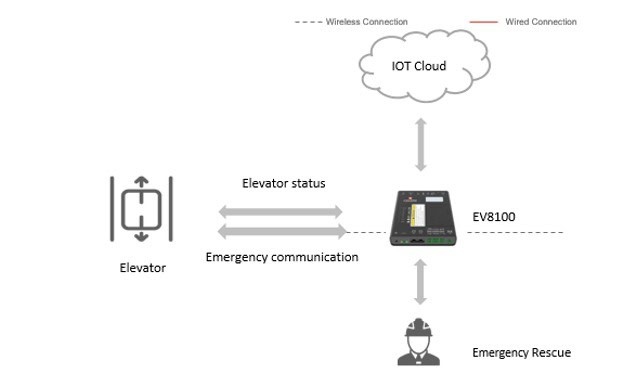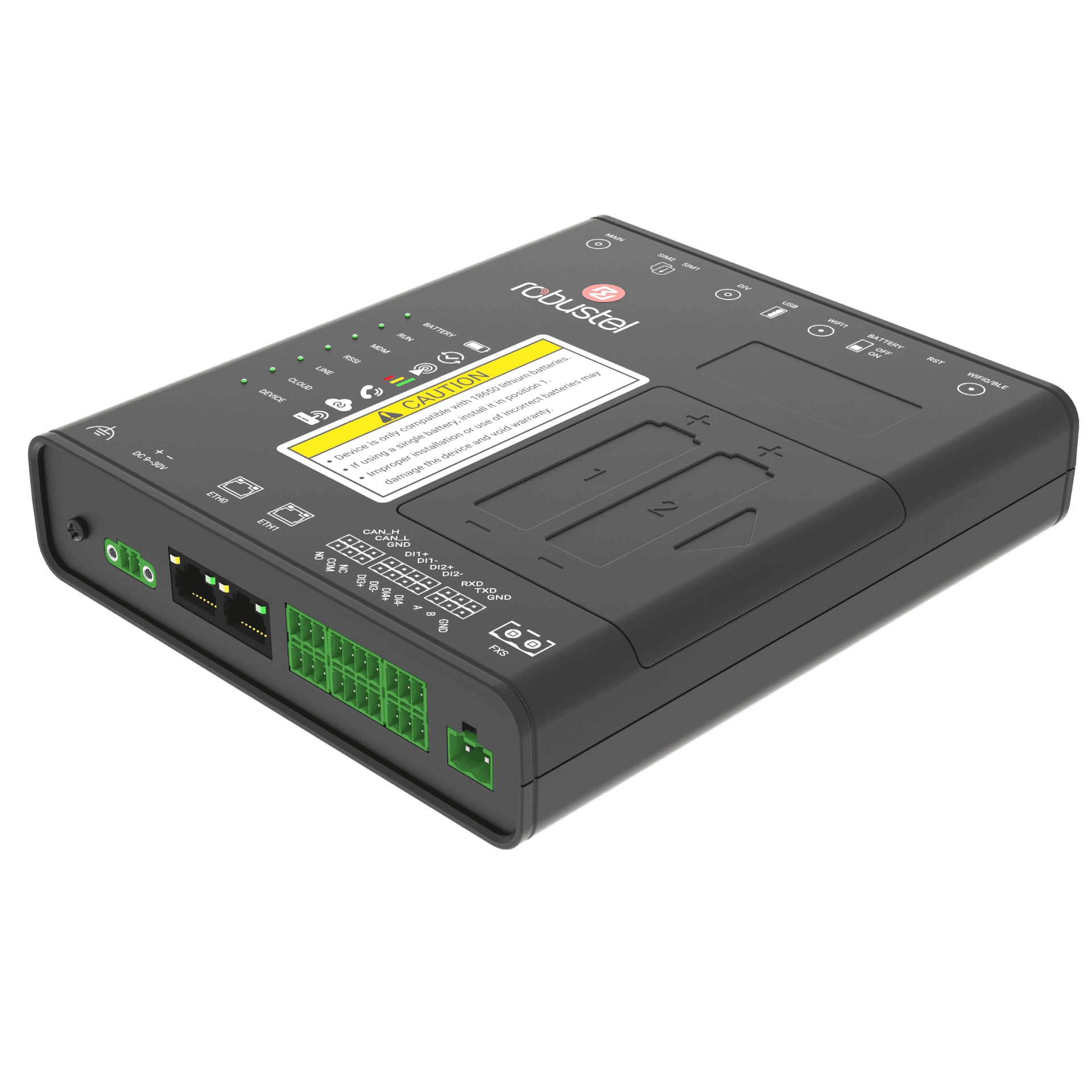Replacing PSTN Elevator Emergency Phones With 4G/VoLTE and VoIP with the EV8100
A Robustel Application Example
Application Example – Fast Facts
Industry
Smart Cities, Building Operations, Elevator Safety and Compliance
Product(s)
Robustel EV8100 Elevator/VoLTE/VoIP Gateway; RCMS (RobustLink, RobustVPN)
Challenges
Legacy PSTN/POTS lines that power elevator emergency phones are being withdrawn, but building owners are still required to provide a working emergency call path to a 24/7 monitoring centre. They need a compliant alternative that works in real elevator conditions, without rewiring the building.
Expected Outcomes
A reliable emergency call link over 4G/VoLTE or VoIP, so a trapped passenger can reach a live operator, be identified by site and car, and get help — all without keeping expensive analogue copper alive just for one button.
Replacing Copper Phone Lines in Elevators With Cellular Voice or VoIP
Every lift car has an alarm button. When someone presses it, they expect to speak to a human who can identify the site, work out what’s happening, and trigger the right response. For years that call went out over an analogue PSTN or POTS line that ran up the shaft. Those lines are now being retired in many regions, and the cost of keeping them active for “just the lift phone” is getting harder to justify.
The EV8100 is built for that exact moment. It sits in or near the lift control panel and replaces the copper line with a managed, testable path over either 4G/VoLTE (cellular voice) or VoIP/SIP (IP voice). That means the help button still works, the monitoring centre still gets a call it can answer and log, and the building stays on the right side of its safety obligations — without relying on legacy telecom infrastructure that is going away.
Business Challenges
Before a building can switch from copper to mobile/IP for elevator emergency calls, facilities, compliance, and lift maintenance teams usually raise the same set of questions. These concerns are what block sign-off if they’re not addressed clearly:
- PSTN/POTS withdrawal is forcing the issue: Many buildings are paying monthly for one analogue line per lift bank purely to keep the alarm phone “legal.” Carriers are actively removing those services or charging a premium to keep them alive. That spend does not scale across a portfolio.
- Safety codes still apply after the line is gone: When the passenger presses the alarm, they must reach a staffed monitoring centre — not a voicemail or softphone that may or may not be open. The operator must be able to identify the building and, in multi-car banks, the specific cabin. In some regions, calls must be recorded and time stamped for audit.
- Voice clarity matters in a confined space: If someone is trapped or unwell, the operator needs to hear them clearly enough to assess the situation and decide whether to dispatch building security, a lift technician, or emergency services. “It usually works unless the car is between floors” is not acceptable to insurers or regulators.
- Lift shafts are hostile RF and electrical environments: You’re installing in steel structures, basements, cores, and machine rooms with poor signal and electrical noise. A consumer-grade modem or improvised mobile phone is not reliable. You need hardware designed to hold registration and drive an external antenna where required.
- Proving it works is part of staying covered: Inspectors, safety officers, and insurance assessors do not just ask “was it commissioned.” They ask “is it functioning today.” Building teams need a way to verify that the emergency path is live — without riding every lift and manually pressing the button every week.
Solution Overview

The EV8100 replaces ageing copper with a voice gateway designed specifically for lift emergency calling. It preserves the “press button, speak to operator” experience but moves the transport to 4G/VoLTE or VoIP. Here is how it is typically deployed:
- 4G/VoLTE call path: Direct cellular voice: The EV8100 places a live 4G/VoLTE call from the lift car to the monitoring centre. The passenger speaks to a human operator over a dedicated mobile voice channel, with consistent caller identity so the operator knows which building and (if configured) which car is calling.
- VoIP/SIP call path: IP voice integration: Where the alarm centre expects VoIP instead of traditional voice, the EV8100 can deliver the emergency call as SIP/VoIP. This lets the lift car integrate into an IP-based monitoring desk without keeping an analogue line active.
- Built for elevator duty, not office desks: Designed for the shaft: The EV8100 is engineered for electrical noise, RF shielding, and tight spaces in lift control areas. This avoids the “consumer modem taped inside the panel” approach that tends to drop registration or fail unpredictably.
- No need to extend corporate IT into the shaft: Self-contained path: You do not have to drag the building LAN, PBX, or firewall rules into the lift controller cabinet. The EV8100 handles the call path locally and hands off to the monitoring centre in the format they are ready to receive.
- Testability and service visibility: Maintainable at scale: Because the voice/VoIP path runs through a known gateway, service teams can verify status, check registration, and confirm call readiness without physically triggering a panic call in every single car. For multi-site portfolios, this saves hours per inspection cycle.
Expected Customer Outcomes
What success looks like for the building operator and the lift service partner
For the operator / asset owner:
- Regulatory compliance without legacy copper: The lift emergency phone still connects to a staffed 24/7 monitoring centre, using 4G/VoLTE or VoIP, even after PSTN/POTS lines are withdrawn.
- Clear evidence for safety audits and insurance: You can demonstrate that the emergency call path is powered, registered, and callable today. You’re not relying on a test log from six months ago.
- Lower cost per lift bank across the estate: You stop paying for one analogue circuit per elevator group. You move to a repeatable cellular/IP model that you can standardise across all managed buildings.
For the lift service partner / maintainer:
- A repeatable retrofit kit, not a one-off hack: You can walk into a site with ageing copper and leave with a working 4G/VoLTE or VoIP emergency call path that the monitoring centre will accept.
- Fewer nuisance call-outs: Because the EV8100 is purpose-built for elevator environments, you avoid constant return visits to restart improvised hardware that was never meant to live in a lift shaft.
- A stronger commercial position with building management: You are not only keeping the lift mechanically available. You are delivering a compliant, testable emergency communications channel that facilities managers can defend in front of auditors, safety officers, and insurers.
Featured Products
Robustel EV8100 Elevator Gateway

RCMS Cloud Device Management

Talk to an Expert
If you still rely on copper lines in your elevator shafts — or you have already been told those lines are being shut down — you’re on the clock.
Let’s talk about moving your lift emergency phones to a 4G/VoLTE or VoIP call path with the EV8100, so you stay compliant, provable and serviceable without keeping legacy PSTN alive.
